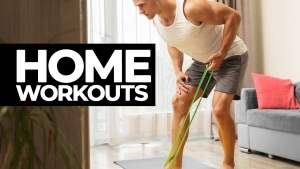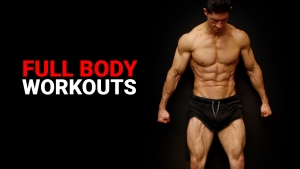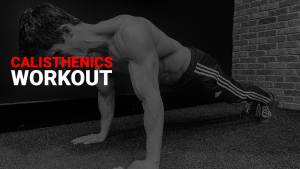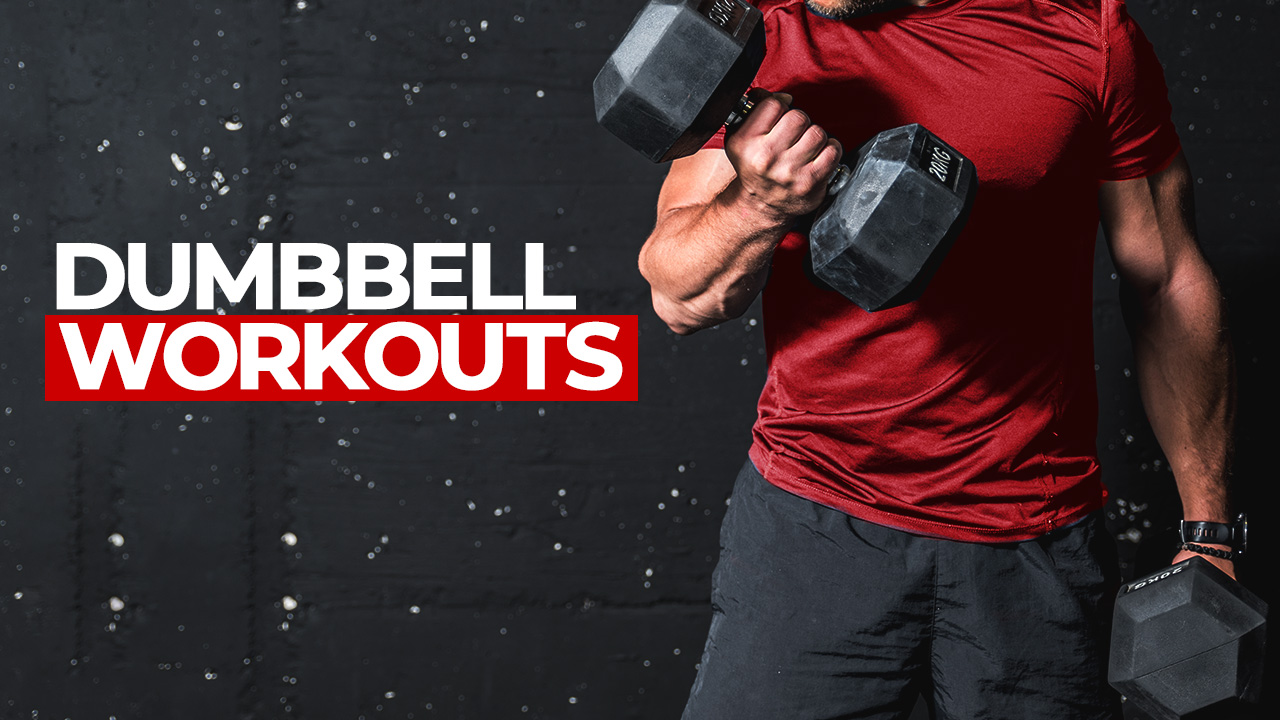
THE ULTIMATE DUMBBELL WORKOUT GUIDE
So, you’ve included the classic dumbbell Bench Press and Bent-Over Row in your dumbbell workout routine.
Think your bases are covered?
Think again!
There’s much more to dumbbell workouts than you might realize.
If you’ve noticed your progress is plateauing or you’re not seeing results from your workouts, this comprehensive guide to dumbbell exercises is for you.
Below, I provide an overview of muscle groups targeted by dumbbells to help you understand how the best dumbbell exercises work.
Then, I will give you all the dumbbell workouts you’ll need, regardless of the type of exercise equipment you have.
Whether you’re going to a fully equipped gym, or you only have a pair of dumbbells at home, I’ve got you covered.
I’ll also address some frequently asked questions related to dumbbell workouts including how to target specific muscle groups, how to enhance muscle growth, and how often you should be training with dumbbells.
Ready to trade in your barbells for dumbbells?
Here are the topics that I’ll cover in this dumbbell training guide:
1) ARE DUMBBELL WORKOUTS EFFECTIVE?
In short, YES! Dumbbell workouts are highly effective.
Here’s why I swear by dumbbell training:
Compact and Convenient: Dumbbells are ideal for small spaces, making them perfect for home workouts. This accessibility allows for more consistent training.
Dynamic and Athletic: Training with dumbbells encourages movements that are dynamic and mimic athletic motions. This helps improve agility and coordination.
Full Range of Motion: Dumbbells allow exercises to be performed in all three planes of movement, which can enhance core stability and muscle balance. This is a capability that barbells often cannot match due to their size and the nature of the exercises typically performed with them.
Efficiency: Dumbbell exercises often engage multiple major muscle groups at once. This means workouts can be shorter yet still very impactful, maximizing the efficiency of your training session.
Adaptability: The versatility of dumbbells allows for a wide range of exercises, making it possible to target virtually every major muscle group in the body. This adaptability makes it easy to construct a full-body workout with just dumbbells.
2) WHAT ARE THE BEST DUMBBELL WORKOUTS TO BUILD MUSCLE?
With the benefits of dumbbell workouts out of the way, let’s take a closer look at the best dumbbell workouts to build muscle.
Instead of breaking down the best dumbbell exercises based on isolated muscle groups (I’ll be doing that next!), I’m going to provide a total body workout.
One that focuses on big, powerful multi-joint movements.
Performing these dumbbell exercises will ensure that you hit all of the major muscle groups in one intense workout.
Ready to get started?
RENEGADE ROW DUMBBELL DEATH MARCH


HOW TO DO THE RENEGADE ROW DUMBBELL DEATH MARCH:
- Begin in a plank position with your feet shoulder-width apart. Place a dumbbell in each hand directly under your shoulders, using a neutral grip (palms facing each other).
- Activate your core and glutes to maintain a straight alignment from your head to your heels. Ensure your hips don’t sag and keep your buttocks from lifting.
- Raise one dumbbell by bending your elbow and drawing it towards your hip, ensuring your elbow stays close to your side. Keep your body as stable as possible, resisting the urge to twist your hips or shoulders.
- If space allows, as you lower the dumbbell back to the starting position, step forward with the opposite foot. Then, perform a row with the other arm and step forward with the other foot. This creates a “walking” motion.
- Alternate the rowing arm and stepping foot with each row as you move forward.
WHAT MAKES IT EFFECTIVE: The Renegade Row Dumbbell Death March is an efficient total body exercise that engages multiple muscle groups, including the upper body, core, and legs, through a combination of Dumbbell Rows and forward stepping motions.
DUMBBELL THRUSTER

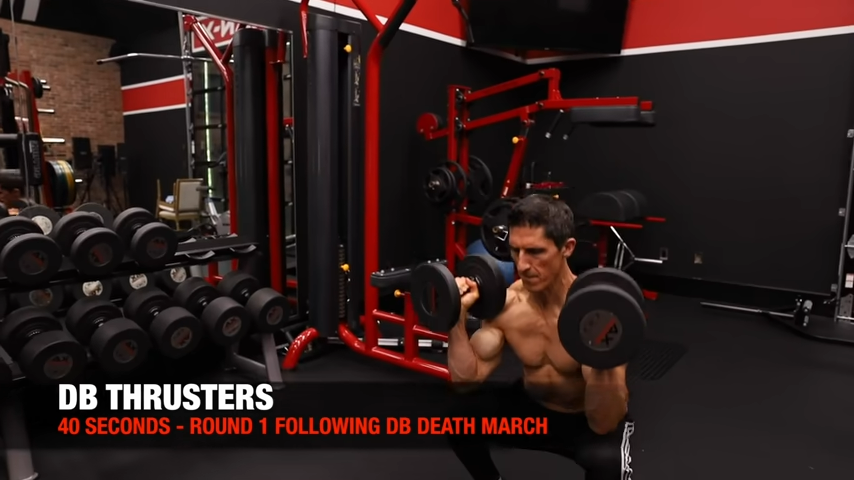
HOW TO DO THE DUMBBELL THRUSTER:
- Hold a dumbbell in each hand and raise them to shoulder height, with the elbows pointing forward and the dumbbells resting at shoulder level. This is similar to the rack position in weightlifting.
- Initiate the movement by sending your hips back and bending your knees to lower into a squat. Keep your upper chest up and your back straight as you descend.
- Go down until your thighs are at least parallel to the ground, ensuring your knees are aligned with your toes.
- Powerfully push through your heels to explosively rise from the squat position. Use this generated momentum to drive the dumbbells overhead.
- As you reach the top of the squat, press the dumbbells up, fully extending your arms overhead. Keep your core tight and engaged to support your spine.
- After fully extending your arm muscles, carefully lower the dumbbells back to your shoulders as you simultaneously prepare to enter the next repetition.
WHAT MAKES IT EFFECTIVE: The Dumbbell Thruster is a dynamic total body exercise that combines a squat with an overhead press, engaging multiple muscle groups such as the quadriceps, hamstrings, glutes, shoulders, and core. This compound movement enhances strength, boosts cardiovascular health, improves coordination and balance, and increases functional fitness.
DUMBBELL SPRINTER LUNGE


HOW TO DO THE DUMBBELL SPRINTER LUNGE:
- Begin in a standing position with your feet about hip-width apart, holding a dumbbell in each hand at your sides.
- Step one foot backward into a reverse lunge. Keep your front foot firmly planted and use the ball of your back foot for balance.
- As you descend into the lunge, keep the majority of your weight on your front leg. Your back knee should lower toward the ground but not touch it.
- When you reach the bottom of the lunge, tilt your torso forward from the hips. Aim to get your chest close to your knee. This forward lean intensifies the engagement of the glutes, hamstrings, and erectors in your lower back.
- Ensure your back remains straight and neutral throughout the movement to avoid straining it.
- Concentrate on pushing through the heel of your front leg to rise back up to the starting position. This focuses the exercise on the front leg, maximizing the activation of the glutes and hamstrings.
- Avoid relying too much on the back leg to push off; keep the effort centered on the front leg.
WHAT MAKES IT EFFECTIVE: The dumbbell sprinter lunge effectively targets the posterior chain, emphasizing the glutes, hamstrings, and lower back by tilting the torso forward during each reverse lunge. This exercise strengthens the lower body, particularly through the front leg, while engaging the core for stability. It also enhances balance and coordination, making it ideal for improving functional fitness and athletic performance.
CLOSE GRIP SQUEEZE UPS

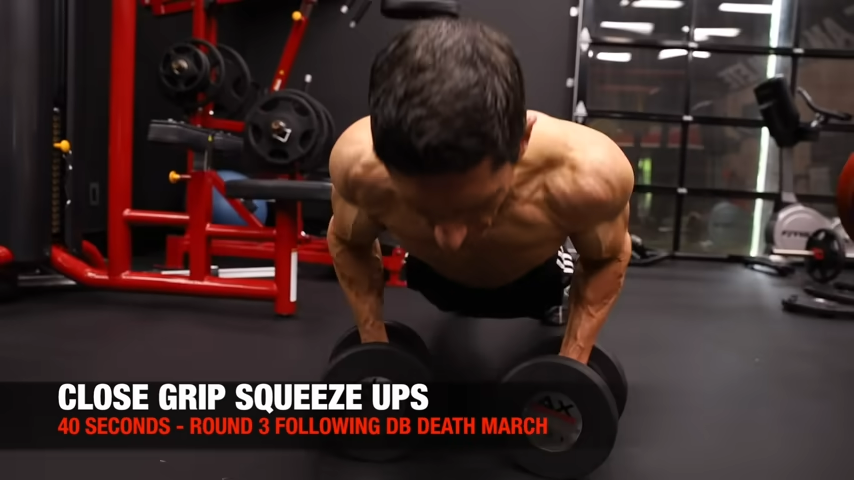
HOW TO DO THE CLOSE GRIP SQUEEZE UP:
- Place the light dumbbells on the floor where you can easily reach them. They should be close enough to each other so that you can grip them with a neutral grip (palms facing each other) and bring them near your chest.
- Lie face down on the floor and grab the dumbbells with a neutral grip.
- Set yourself in a standard push-up position with the dumbbells under your chest, keeping your hands close together. Your arms should be fully extended, body straight from your head to your heels, and feet together or no more than shoulder-width apart for stability.
- Tighten your core and keep your shoulder blades packed against the back of your rib cage. This position stabilizes your upper body and helps focus the exertion on your chest and arms.
- Lower your body towards the floor by bending your elbows, keeping them close to your body to enhance tricep engagement.
- As you push back up, focus on squeezing the dumbbells towards each other without actually moving them. This action creates additional tension in your chest muscles, maximizing the workout’s effectiveness.
- The squeeze should be forceful but controlled, ensuring you engage your pecs throughout the motion.
WHAT MAKES IT EFFECTIVE: Close Grip Squeeze Ups effectively enhance traditional Push-Ups by adding a squeezing motion, significantly increasing chest and tricep activation. This exercise also engages the core and shoulders, boosting upper body strength and stability. The added squeeze intensifies muscle engagement, making it a comprehensive workout for building strength and coordination across multiple muscle groups.
DUMBBELL HIGH PULLS FROM THE FLOOR

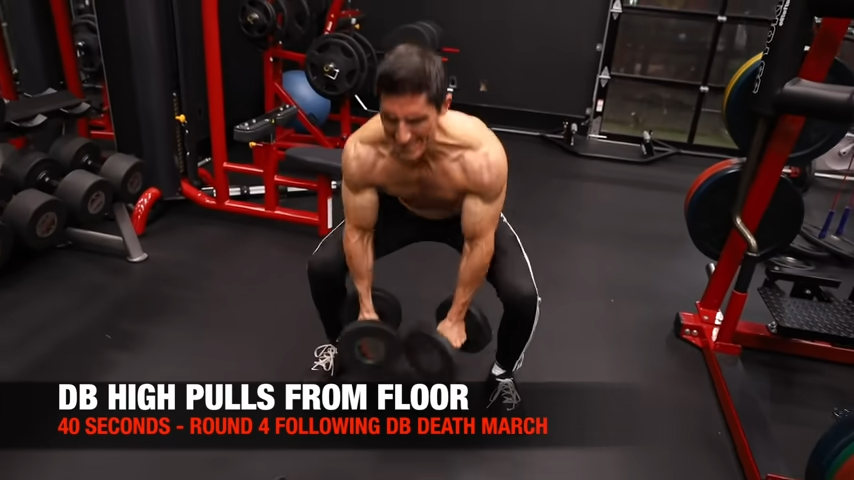
HOW TO DO DUMBBELL HIGH PULLS FROM THE FLOOR:
- Stand with your feet shoulder-width apart or squat stance for stability. Place a dumbbell in front of each foot.
- Bend at your hips and knees to squat down and grasp each dumbbell. Keep your back flat and chest up to avoid rounding your spine.
- Start with a slight bend in your arms, maintaining a firm grip on the dumbbells.
- Explosively stand up by extending your hips and knees. Simultaneously, ‘rip’ the dumbbells off the floor by pulling them upwards with force.
- Keep the dumbbells close to your body as you pull them. Lead with your elbows and ensure that as you reach the top of the movement, your thumbs are higher than your pinkies, which helps in keeping the wrists in a neutral position.
- Continue to lift the dumbbells until they reach shoulder level. Ensure your elbows are higher than the dumbbells at the top of the movement.
- At the top, your body should be fully upright, and the dumbbells should be positioned close to your shoulders.
- After reaching the proper range of motion, carefully lower the dumbbells back to the starting position on the floor, controlling the movement to avoid any jerking motions.
WHAT MAKES IT EFFECTIVE: By requiring full body integration and control, High Pulls from the Floor also help to develop functional strength and improve movement efficiency, making them a valuable addition to any fitness regimen.
3) WHAT IS THE BEST DUMBBELL WORKOUT FOR BACK?
When choosing the best dumbbell exercises for the back, I didn’t just copy what I saw in other videos or use misleading data.
Instead, as a physical therapist and personal trainer, I based my picks on solid science, focusing on maximizing results while preventing injuries and correcting posture.
Here are my go-to dumbbell exercises for the back:
WEIGHTED PULLUP


HOW TO DO THE WEIGHTED PULLUP:
- One common method to secure the dumbbell is by using a weight belt with a chain that can hold the dumbbell. If you don’t have a weight belt, you can place the dumbbell between your feet, squeezing them together to hold it securely as you perform the pull-up.
- Position yourself beneath the pull-up bar and grasp it using an overhand grip, with your palms facing forward and your hands spaced slightly wider than shoulder-width apart.
- Pull your body up towards the bar by bending your elbows and driving them to your sides.
- Keep your core tight and avoid swinging your legs; the movement should be controlled and steady.
- Continue to pull yourself up until your chin is above the bar, focusing on using your upper body strength rather than momentum.
- Lower yourself slowly and with control until your arms are fully extended again.
- Breathe in as you go down and prepare for the next repetition.
WHAT MAKES IT EFFECTIVE: Weighted pull-ups are highly effective for back development because they increase resistance, intensify muscle engagement, and promote strength and hypertrophy, particularly in the latissimus dorsi and other upper back muscles.
DUMBBELL DEAD ROW

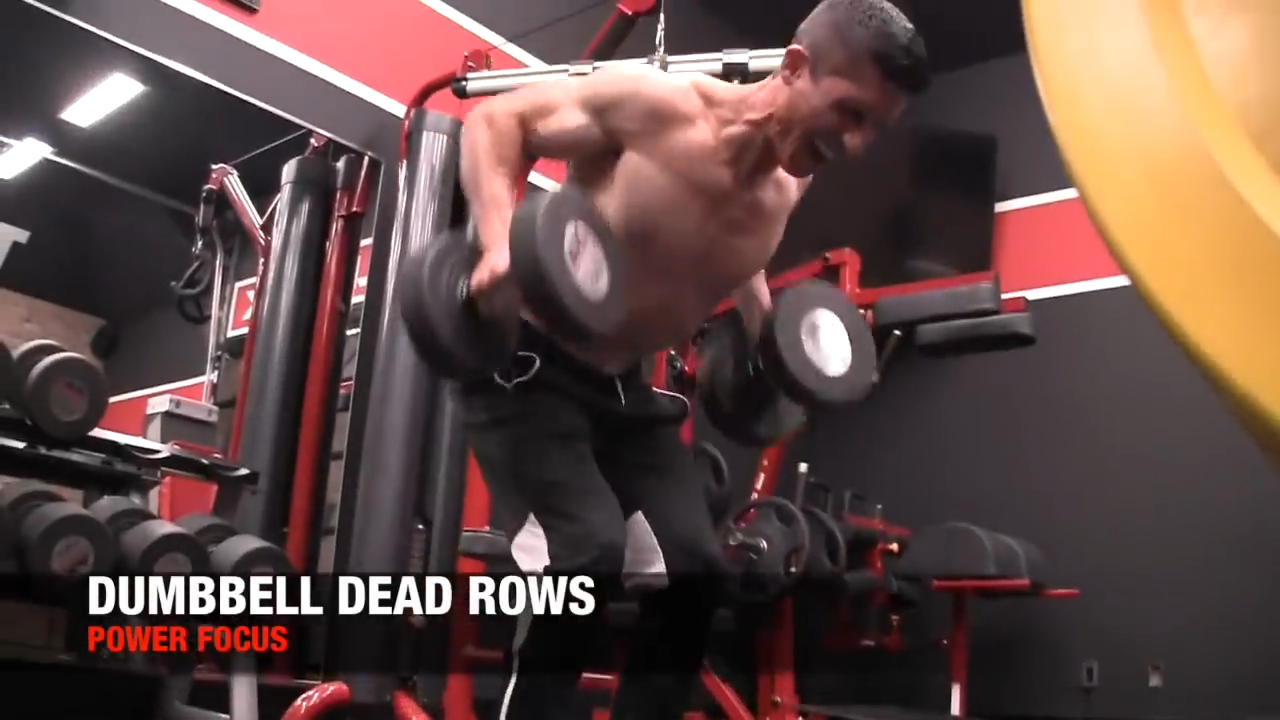
HOW TO DO THE DUMBBELL DEAD ROW:
- Begin this rowing variation by standing with your feet hip-width apart, bending forward into a hinge position with a slight bend in your knees, and placing your hands on dumbbells positioned on the floor beside you.
- Initiate the movement by pushing forcefully through your feet, similar to a Dumbbell Deadlift, lifting the dumbbells to knee level.
- From there, drive your elbows back behind your torso, pulling the weights up in a rowing motion before returning to the starting position.
- Throughout the exercise, maintain a tight core and adhere to strict form to prevent injuries.
WHAT MAKES IT EFFECTIVE: This exercise combines elements of a Deadlift and a Row, primarily activating the lats.
DUMBBELL PULLOVER

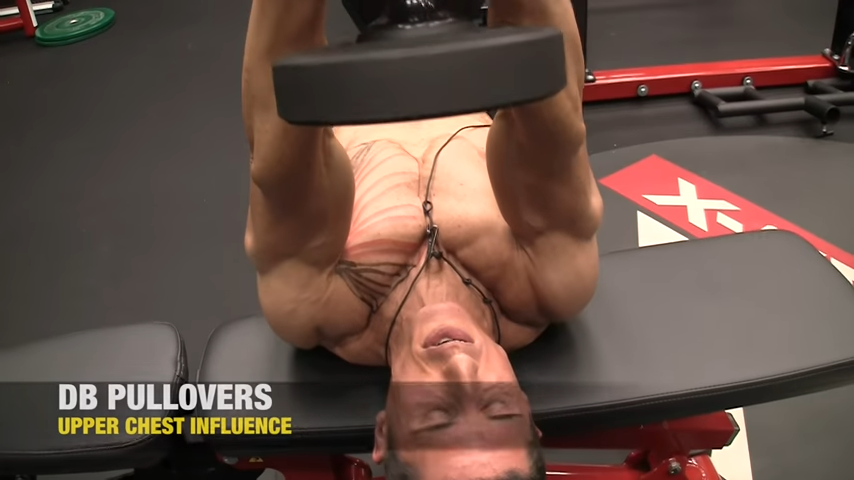
HOW TO DO THE DUMBBELL PULLOVER:
- Position your body perpendicularly on an adjustable weight bench, with your feet shoulder-width apart and knees slightly bent, allowing your hips to drop slightly.
- Hold a single dumbbell with both hands overhead, keeping your torso parallel to the floor.
- Begin the exercise by lowering the dumbbell back over your head with your arms extended and a slight bend in your elbows.
- Then, raise the dumbbell back to the starting position, ensuring your shoulder blades maintain contact with the bench throughout the movement.
- Focus on maintaining core and spinal stability, including careful attention to the thoracic and cervical spine, to prevent injuries and ensure proper form.
WHAT MAKES IT EFFECTIVE: The dumbbell pullover is an effective back exercise that primarily activates the latissimus dorsi by extending the arms overhead and pulling the weight back, thus extensively engaging and stretching the lats to enhance their width and thickness.
These movements are just the highlights of my full list of dumbbell exercises for the back. Check out the entire list now!
4) WHAT IS THE BEST DUMBBELL WORKOUT FOR CHEST?
I’m excited to share my favorite chest exercises using only dumbbells, despite the challenge of not having a heavy barbell.
Dumbbells make a great solution for home workouts where weight equipment options like barbell exercises and weight plates are limited.
Don’t worry, I’m not going to have you doing equipment-heavy exercises like the Barbell Bench Press.
Instead of offering a random assortment of exercises, each exercise I recommend is chosen with a specific purpose to target the upper, mid, and lower chest.
Let’s jump into it:
DUMBBELL WEIGHTED DIP

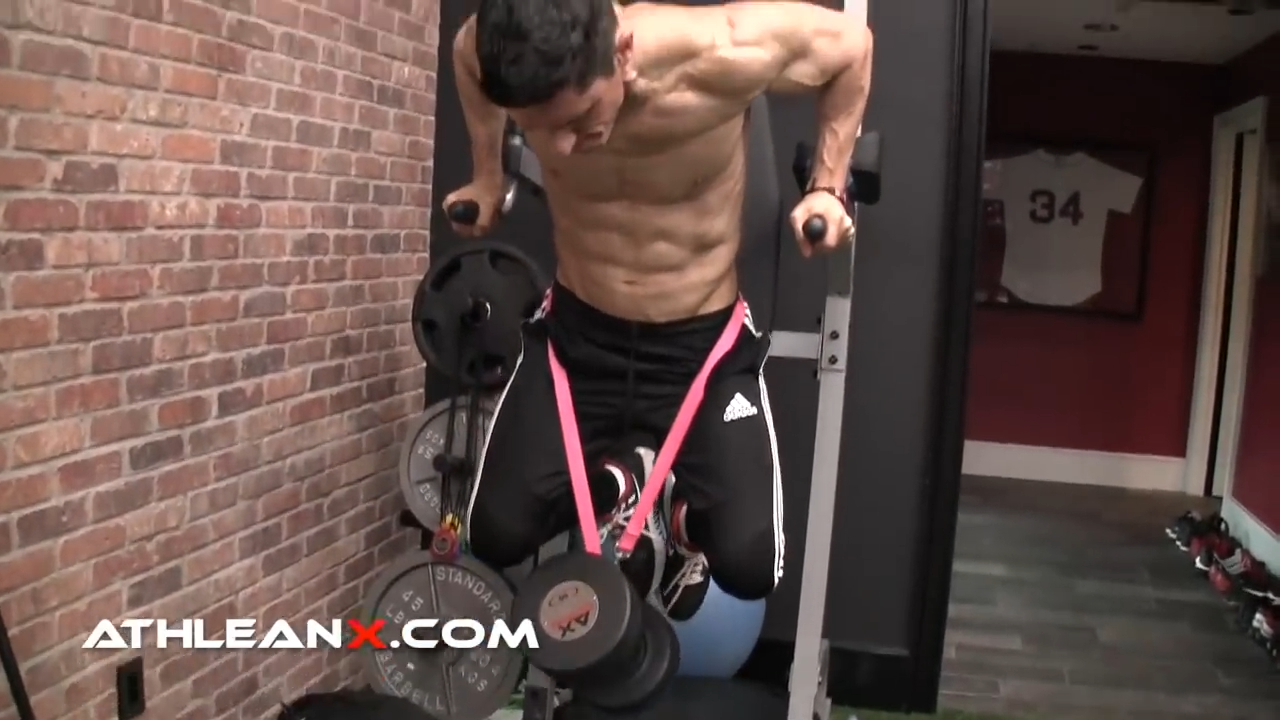
HOW TO DO THE DUMBBELL WEIGHTED DIP:
- Secure the dumbbell around your waist using the dog leash technique, then position yourself on the dip apparatus.
- Start by lowering your body, keeping your elbows bent at a 90-degree angle at the lowest point of the movement.
- Next, brace your core and contract your chest to press upwards, returning to the starting position.
- Throughout the exercise, maintain tight core engagement to ensure proper form.
WHAT MAKES IT EFFECTIVE: The Weighted Chest Dip is an effective exercise for developing the chest muscles because it involves a deep range of motion that thoroughly engages the pectoral muscles, as well as the triceps and anterior deltoids.
PLYO TAP

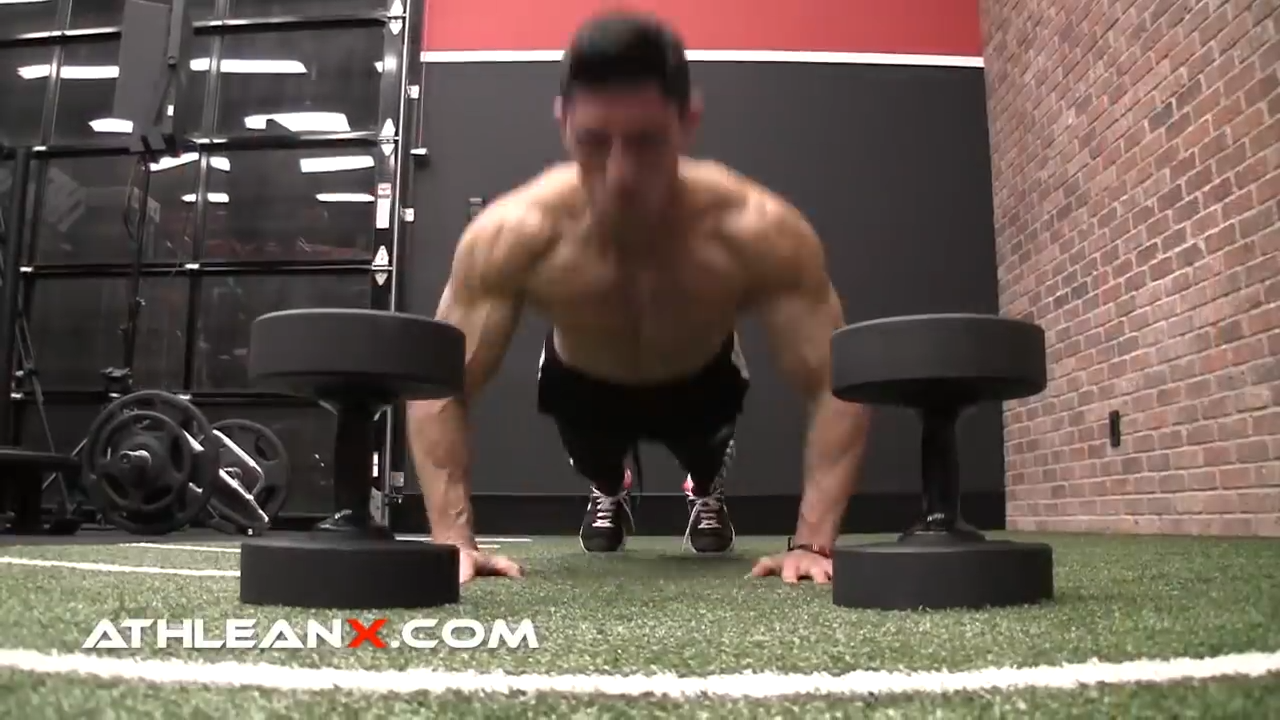
HOW TO DO THE PLYO TAP:
- Begin in a high plank position with a set of dumbbells positioned upright in front of you.
- Execute plyometric push-ups by dynamically pushing off the ground and tapping the tops of the dumbbells with each repetition, without pausing between reps.
- Throughout the exercise, maintain a tight core to support your movement.
WHAT MAKES IT EFFECTIVE: As you progress to heavier dumbbells, their increased height will require you to push off the ground with greater speed and explosiveness.
ECCENTRIC FLOOR FLY

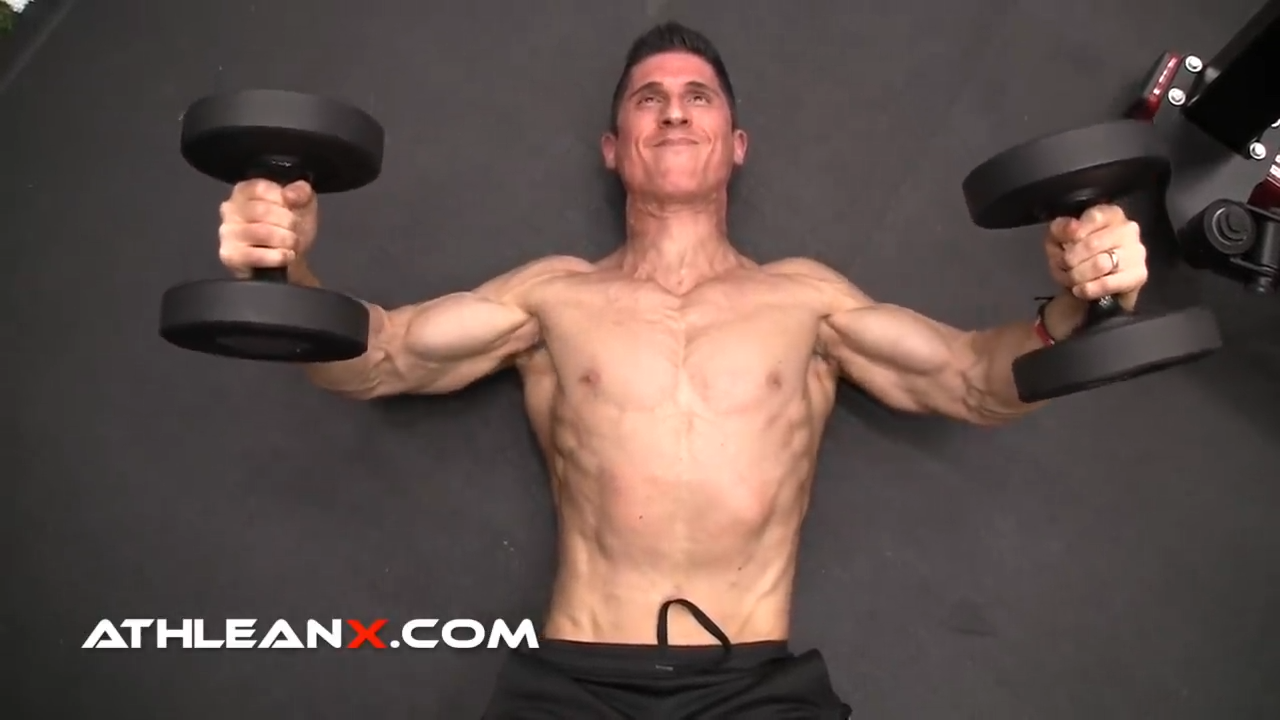
HOW TO DO THE ECCENTRIC FLOOR FLY:
- To start this variation of the dumbbell fly, lie on the floor in a neutral position with the dumbbells pressed directly overhead at a 45-degree angle to your chest, keeping your arms shoulder-width apart.
- Perform the movement as you would a normal bench press by pressing the dumbbells to the top.
- Then, slowly lower the weights with a slight bend in your elbows, similar to a dumbbell fly, focusing on the eccentric portion to emphasize stress on the pectoral muscles.
WHAT MAKES IT EFFECTIVE: This exercise excels in inducing eccentric muscle fiber damage, which is key to stimulating growth in the chest muscles. By emphasizing the lowering phase, it increases the time under tension and the overall strain on the muscle tissue fibers, leading to enhanced muscle growth and strength in the pectorals.
Ready to take your chest workouts to the next level? Click here to access the full list of effective dumbbell chest exercises designed to boost strength and muscle growth.
5) WHAT IS THE BEST DUMBBELL WORKOUT FOR TRICEPS?
Looking to build bigger triceps with just a few pairs of dumbbells and more exercises than just Triceps Extensions?
You can still build large amounts of muscle growth when training with dumbbells—if you use the right exercises.
I recommend incorporating a few of these tricep-focused exercises into your regular arm or upper body workout, depending on your goals, rather than trying to fit all into one session.
DUMBBELL CLOSE GRIP BENCH PRESS

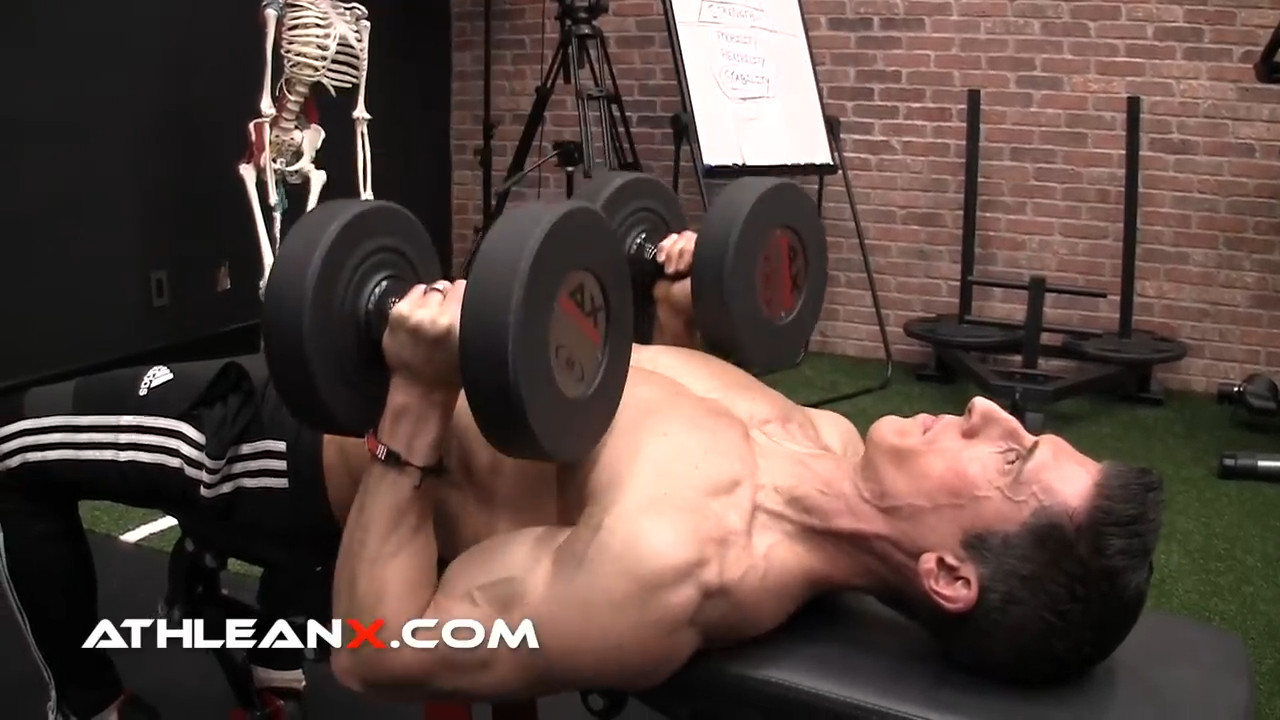
HOW TO DO THE DUMBBELL CLOSE GRIP BENCH PRESS:
- Begin by lying on a flat bench with your feet flat on the ground, hip-width apart.
- Hold a pair of dumbbells with hands shoulder-width apart, palms facing each other.
- Start with your elbows close to your sides.
- Extend your arms upward by straightening your elbows and contracting your triceps, then gradually lower the dumbbells back to the starting position.
WHAT MAKES IT EFFECTIVE: The Dumbbell Close Grip Bench Press is highly effective for tricep development as it allows a deeper range of motion compared to a barbell bench press. The individual movement of each arm forces the triceps to work independently, which can help correct muscle imbalances and strengthen the smaller stabilizing muscles around the shoulder and elbow joints.
LYING DUMBBELL TRICEP EXTENSION

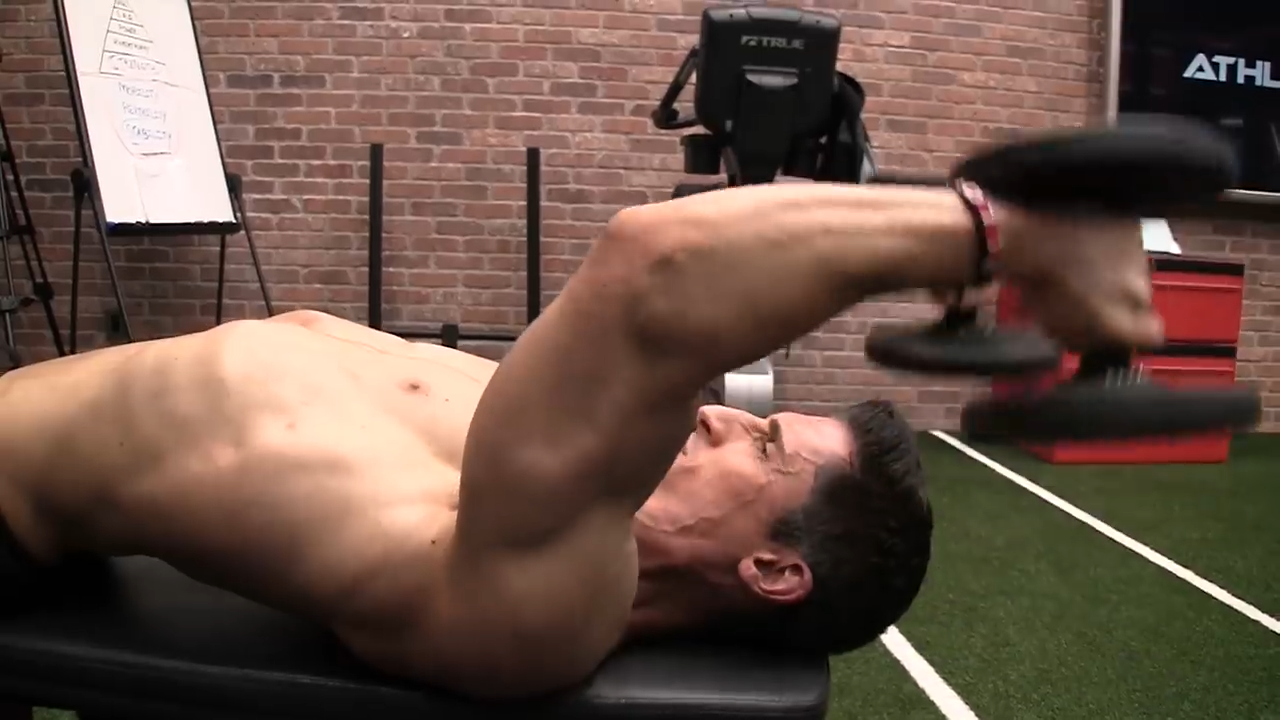
HOW TO DO THE LYING DUMBBELL TRICEPS EXTENSION:
- Start this exercise with a dumbbell in each hand, upper arms slightly angled backward rather than directly overhead, elbows slightly bent.
- Lower the dumbbells behind your head by bending your elbows.
- Then, extend your arms upwards by contracting the triceps, returning to the top of the movement.
- Maintain a tight core throughout to support your posture.
WHAT MAKES IT EFFECTIVE: Overhead Tricep Extensions effectively isolate and target the triceps by moving the arms through a full range of motion. This exercise focuses specifically on the long head of the triceps, which is often less activated in other tricep exercises.
DUMBBELL TRICEPS KICKBACK

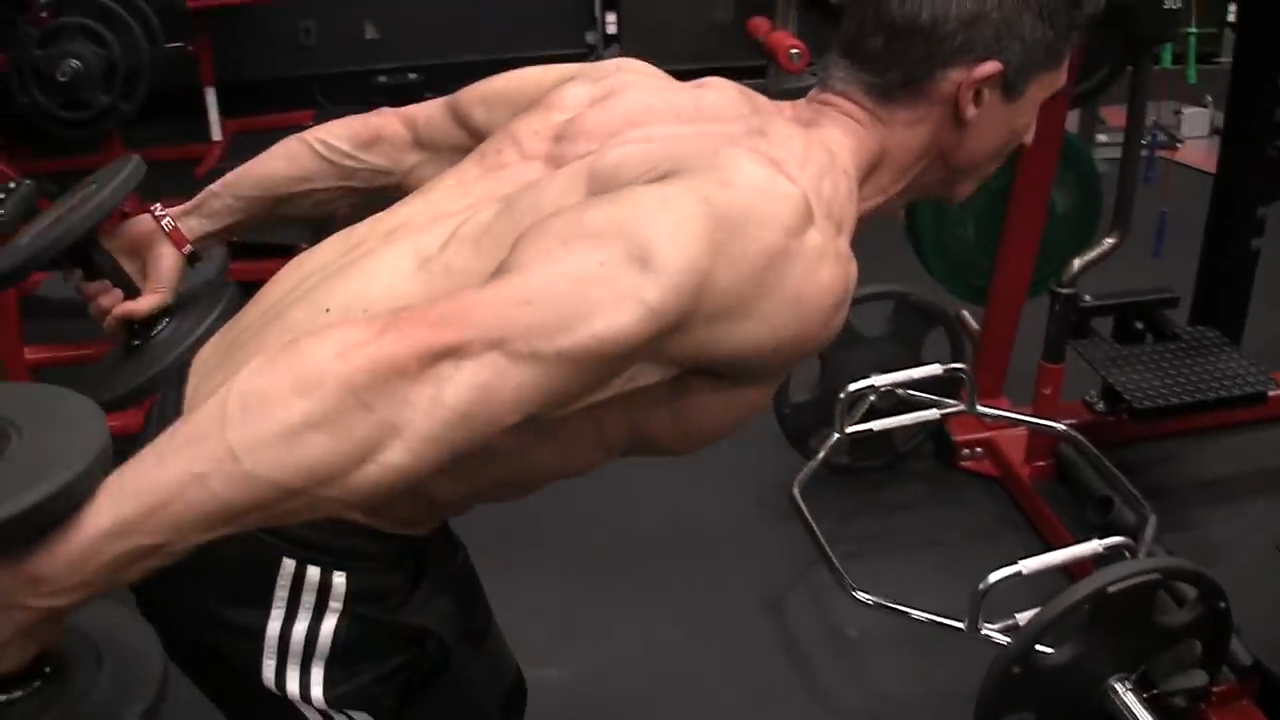
HOW TO DO THE DUMBBELL TRICEPS KICKBACK:
- Begin with a dumbbell in each hand, lean forward. Keep your torso stable and nearly parallel to the ground and tuck your elbows into your sides.
- From this position, extend your elbows, pushing the dumbbells back and contracting the triceps.
- Keep your elbows fixed in position behind your body throughout the exercise to ensure they do not drop as you tire.
WHAT MAKES IT EFFECTIVE: Dumbbell Kickbacks are excellent for focusing on the contraction phase of the triceps muscles. The exercise uniquely targets the lateral head of the triceps, which helps build well-defined arms.
Unlock powerful arm workouts with our comprehensive list of dumbbell triceps exercises. Start sculpting stronger, more defined triceps today!
6) WHAT IS THE BEST DUMBBELL WORKOUT FOR BICEPS?
Can you build bigger biceps muscles with only dumbbells? Absolutely!
Using just a pair of dumbbells can build on the quality of your arm workouts, not compromise your results.
And I have more to offer than the classic Arnold Press for your shoulders.
Let’s explore each dumbbell bicep exercise in detail.
ALTERNATING DUMBBELL BICEPS CURL


HOW TO DO THE ALTERNATING DUMBBELL BICEPS CURL:
- Begin by standing with a dumbbell in each hand.
- Perform the exercise by curling one dumbbell at a time, allowing for concentrated effort on each bicep.
- This method lets you focus on lifting heavier weights with each arm independently, enhancing strength without requiring as much core stability.
WHAT MAKES IT EFFECTIVE: The alternating action allows you to maximize your lifting capacity on each arm, providing an easier path to progressive overload.
INCLINE DUMBBELL CURL

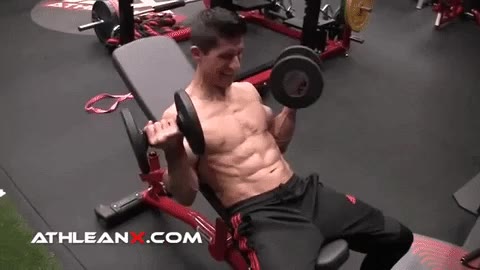
HOW TO DO THE INCLINE DUMBBELL CURL:
- Set the incline bench to an angle between 45 to 60 degrees to enhance the stretch in the biceps throughout the exercise.
- Sit down on the bench with your back firmly against the pad. Plant your feet firmly on the floor for stability.
- Hold a dumbbell in each hand with your arms hanging straight down and palms facing forward. Ensure your arms are fully extended.
- Maintain your elbows stationary and close to your sides as you gradually curl the dumbbells upward toward your shoulders. Focus on engaging your biceps to lift the weights, avoiding any swinging motion with your arms.
- As you lift, rotate your wrists slightly so that your palms end up facing towards your body at the top of the movement to maximize the bicep contraction.
- Pause briefly at the top of the curl when your biceps are fully contracted and the dumbbells are at shoulder level. Make sure your elbows stay back and do not move forward during the curl.
- Slowly lower the dumbbells back to the starting position in a controlled manner. Keep the tension in your biceps throughout the descent and avoid letting the weights just drop.
WHAT MAKES IT EFFECTIVE: The incline dumbbell curl is highly effective for bicep development due to its increased range of motion that extends and stretches the biceps more than standard curls, effectively targeting the long head of the muscle.
DRAG CURL

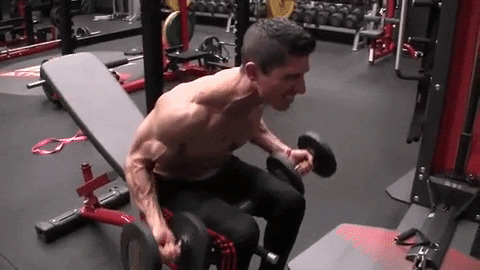
HOW TO DO THE DUMBBELL DRAG CURL:
- Grasp a dumbbell in each hand using an underhand grip (palms facing upwards) and let your arms hang fully extended at your sides.
- Start the curl by pulling your elbows back slightly towards your torso while keeping them pinned to your sides.
- While drawing your elbows backward, simultaneously lift the dumbbells toward your shoulders. Ensure the dumbbells move in a straight line close to your body, as if dragging along your torso.
- Focus on squeezing your biceps as you lift the weights.
- Once the dumbbells are at shoulder level, hold the contraction briefly to maximize bicep activation.
- Slowly lower the dumbbells back to the starting position, keeping the movement controlled and maintaining tension in the biceps.
WHAT MAKES IT EFFECTIVE: This exercise emphasizes the contraction of the biceps at the top of the curl and keeps the biceps under continuous tension by minimizing the involvement of other muscles that typically assist in a standard curl.
Want to build bigger biceps? Explore our full range of dumbbell biceps exercises.
7) WHAT IS THE BEST DUMBBELL WORKOUT FOR LEGS?
Now that the upper body is totally taken care of, it’s time to show some love to the legs!
And I’m talking about more for your legs than the Barbell Squat.
Here are some of the best dumbbell exercises for legs:
DUMBBELL REVERSE LUNGE


HOW TO DO THE DUMBBELL REVERSE LUNGE:
- Stand upright with your feet hip-width apart, holding a dumbbell in each hand by your sides. Consider starting with light weights here. Even if you can squat a lot of weight, try something like 25-pound dumbbells for the first set.
- Step back with one leg, planting the ball of the foot on the ground while keeping the front foot flat.
- Lower your body by bending both knees until the rear knee nearly touches the ground. Ensure your front knee is aligned with your ankle and does not extend past your toes.
- Keep your torso upright and your core engaged throughout the movement.
- Push off the back foot using the heel to help drive you back to the starting position.
- Repeat the movement with the opposite leg.
WHAT MAKES IT EFFECTIVE: The Dumbbell Reverse Lunge is an effective leg exercise because it enhances balance, coordination, and unilateral (one-sided) strength, reducing muscular imbalances between legs. It targets key lower body muscles like the glutes, quads, and hamstrings more safely and naturally than forward dumbbell lunges, minimizing strain on the knee joints.
ROMANIAN DEADLIFT

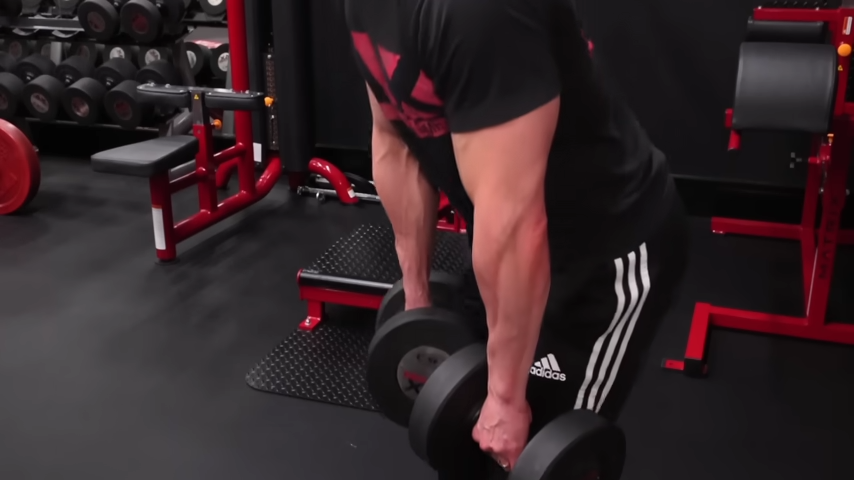
HOW TO DO THE DUMBBELL ROMANIAN DEADLIFT:
- Stand with your feet hip-width apart, each hand holding a dumbbell.
- Initiate the movement by pushing your hips back and allowing the dumbbells to slide down your thighs.
- Continue to push your hips backward as far as comfortably possible while keeping a slight bend in your knees.
- Pause briefly in this position for an isometric hold.
- Then, engage your glutes to reverse the motion, driving your hips forward to return to the standing position.
WHAT MAKES IT EFFECTIVE: This exercise emphasizes the hip hinge movement, crucial for athletic performance and everyday activities, while also improving flexibility and range of motion in the hamstrings.
BULGARIAN SPLIT SQUAT

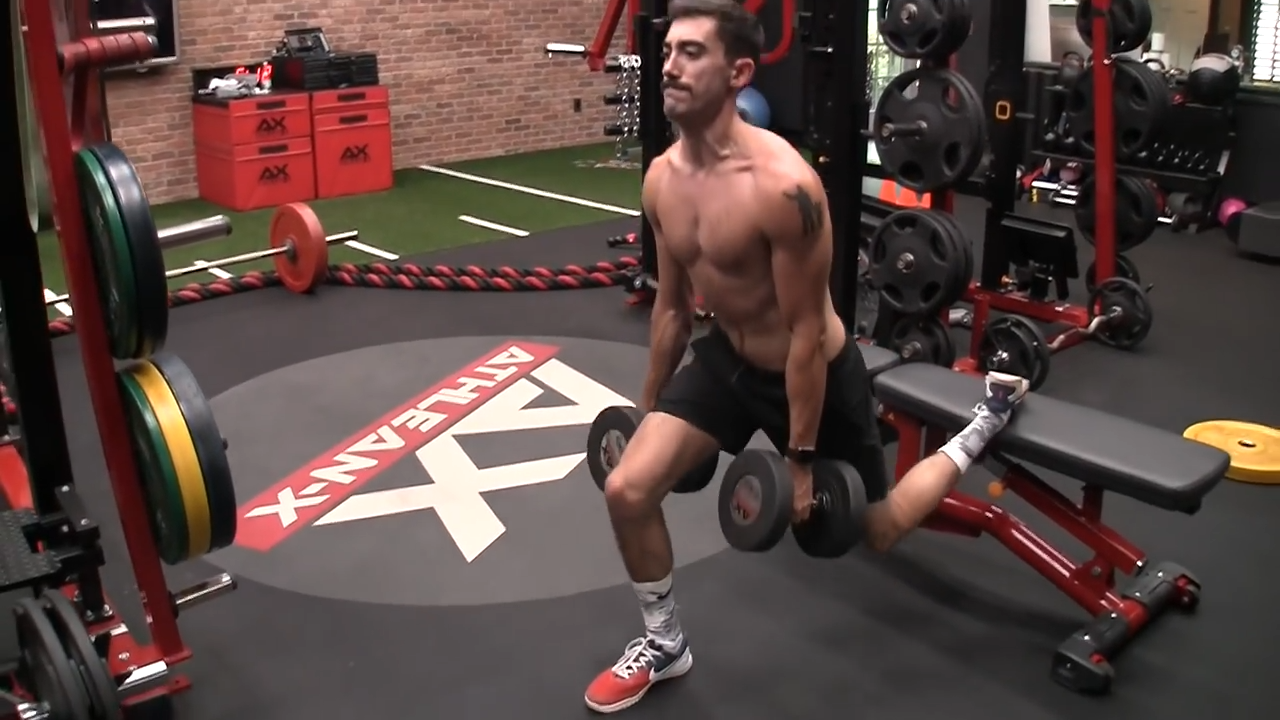
HOW TO DO THE BULGARIAN SPLIT SQUAT:
- Begin by placing your left foot firmly on the ground and your right foot elevated behind you on a bench, holding a dumbbell in each hand by your sides.
- Lower your body towards the floor by bending your front knee, keeping your torso upright to maintain focus on your quads.
- Perform all of your repetitions on one side before switching, placing your right foot on the floor and your left foot on the bench, and repeat the movement.
WHAT MAKES IT EFFECTIVE: This unilateral exercise helps correct muscular imbalances between legs by isolating each side independently. The elevated rear leg increases the range of motion, enhancing muscle activation and improving overall leg strength and flexibility, making it a powerful addition to any lower-body workout routine.
Step up your lower body training with our total list of dumbbell leg exercises. Click here for routines that will strengthen and build up your legs!
8) WHAT IS THE BEST DUMBBELL WORKOUT FOR SHOULDERS?
Looking to build impressive shoulders with just a pair of adjustable dumbbells? You’re in the right place!
I’ll not only share my top picks for dumbbells shoulder exercises but also dive into why they work so effectively.
Each exercise has been carefully selected to ensure you can maximize your shoulder development and achieve those coveted boulder shoulders.
STANDING DUMBBELL PRESS

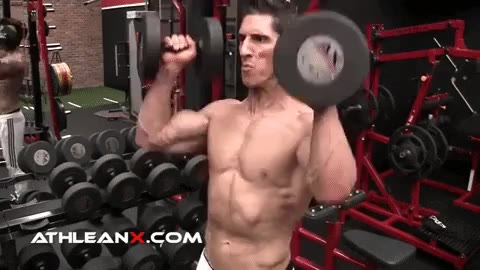
HOW TO DO THE STANDING DUMBBELL PRESS:
- Stand with your feet shoulder-width apart for stability. Hold a dumbbell in each hand at shoulder height, elbows bent and palms facing forward.
- Brace your core and keep your spine neutral.
- Exhale as you push the dumbbells overhead. Ensure that your wrists are in line with your shoulders and avoid locking your elbows at the top of the movement.
- Pause briefly at the top of the explosive press reps to stabilize the weights.
- Slowly lower the dumbbells back to the starting position at shoulder height as you inhale.
- Keep your back straight and avoid arching your lower back as you lift the weights. This can be managed by slightly tucking your pelvis and engaging your core throughout the exercise.
WHAT MAKES IT EFFECTIVE: This exercise is excellent for building strength in the entire shoulder and upper body, involving the deltoids, triceps, and upper trapezius. It also engages the core for stabilization, making it a comprehensive upper-body workout.
STRAIGHT DUMBBELL LATERAL RAISES

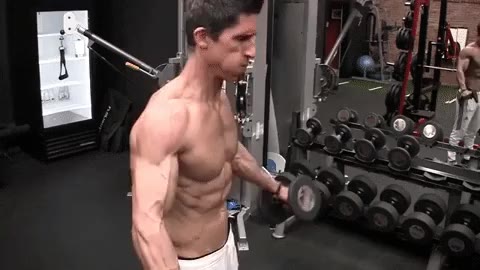
HOW TO DO THE STRAIGHT DUMBBELL LATERAL RAISE:
- Stand with your feet hip-width apart, holding a dumbbell in each hand at your sides. Ensure your palms are facing your body and your arms are straight.
- Begin lifting the dumbbells out to your sides with a slight bend in your elbows to protect the joints. As you lift, keep your thumbs slightly higher than your pinkies to avoid the “pouring the pitcher” motion, which can put unnecessary stress on the shoulder joint.
- Continue to lift the weights until your arms are parallel to the floor, focusing on a strong contraction in the deltoid muscles at the top of the movement. Ensure that your body remains upright and avoid leaning to the side or using momentum to raise the weights.
- Slowly lower the dumbbells back to your sides under control, maintaining tension in your deltoids throughout the descent. Avoid letting the weights drop abruptly which can strain the shoulder muscles.
WHAT MAKES IT EFFECTIVE: This exercise is effective for isolating and strengthening the shoulder muscles, particularly the lateral (side) deltoids, enhancing shoulder width and definition. It’s important to perform it with care to protect the shoulder joint and ensure optimal muscle development.
FIGURE 8

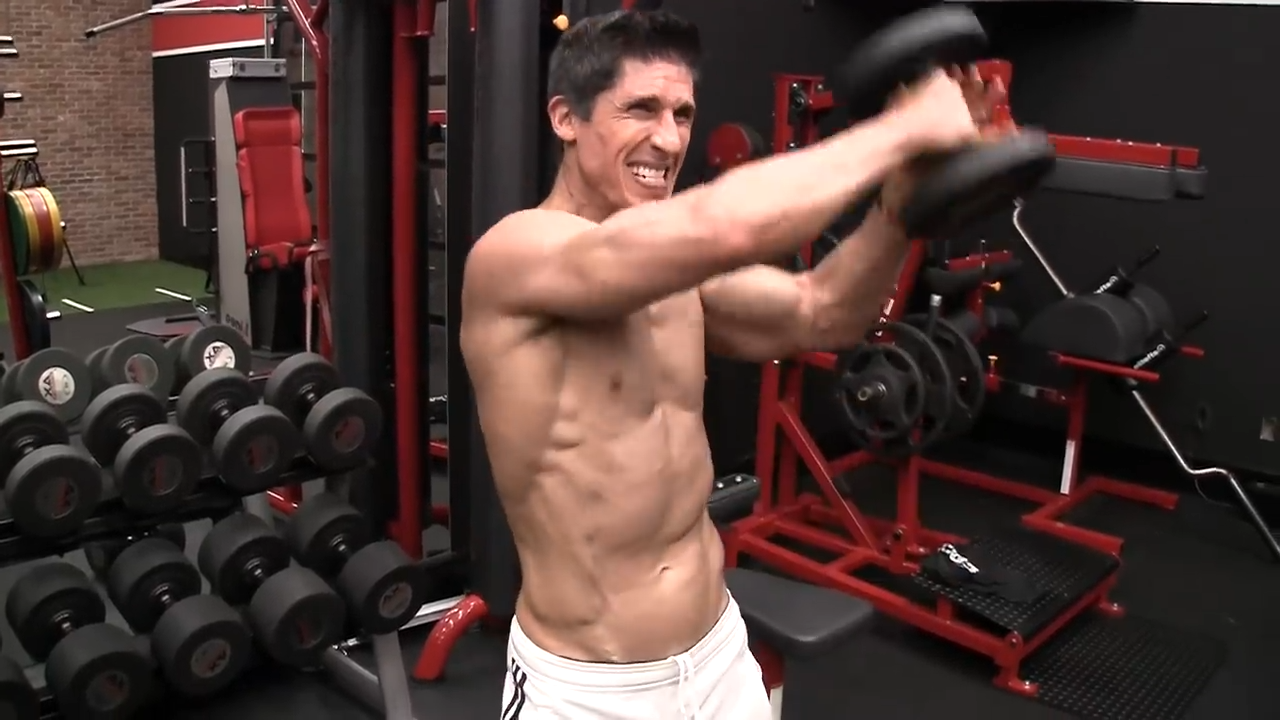
HOW TO DO THE DUMBBELL FIGURE 8:
- Stand with your feet shoulder-width apart, facing forward. Grasp a single dumbbell with both hands and extend your arms straight out in front of you at chest level. Ensure your grip is firm and your arms are steady.
- Begin moving the dumbbell in a horizontal figure 8 pattern. Carefully swing the dumbbell left to right, guiding it to trace an 8-shape in the air in front of you. The movement should be fluid and controlled, focusing on the motion coming from your wrists and arms while keeping the rest of your body stable.
- Keep performing the figure 8 motion continuously, maintaining a controlled pace and steady form. Push yourself until you can no longer maintain the form or you reach muscle fatigue.
WHAT MAKES IT EFFECTIVE: This exercise effectively challenges and builds the shoulder muscles by requiring constant control and movement, enhancing both muscle strength and coordination.
Elevate your shoulder workouts with our extensive list of dumbbell shoulder exercises tailored for shoulder development. Start building broader, more powerful shoulders!
9) WHAT IS THE BEST FULL BODY WORKOUT FOR BEGINNERS?
Ready for a full-body dumbbell workout that you can do at home with just one set of dumbbells, no matter how much space or time you have?
This workout is perfect for anyone, regardless of fitness level, and doesn’t require any additional gym equipment like various types of benches.
If you’re working with adjustable dumbbells, even better!
You can easily adjust the weight to suit your strength without needing multiple dumbbells, saving you space and simplifying your workout routine.
Whether you’re just starting out or looking to maintain your fitness, this guide to total body exercises will help you build muscle effectively at home.
DUMBBELL CLEAN UP AND OVER

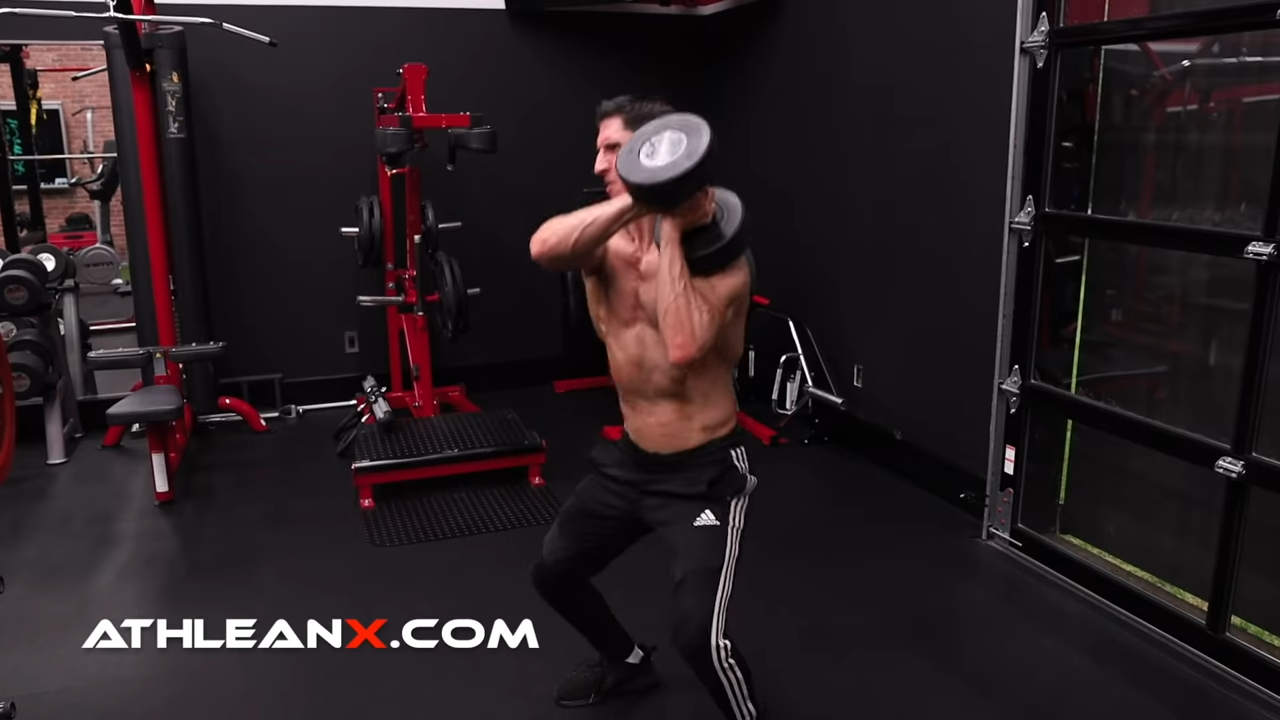
HOW TO DO THE DUMBBELL CLEAN UP AND OVER:
- Stand with your feet shoulder-width apart like in a squat position, facing a dumbbell placed vertically on the ground.
- Squat down slightly and grasp the dumbbell handle with both hands, ensuring your grip is secure.
- Begin the movement by driving throuour heels to lift the gh ydumbbell off the ground. As you lift, use the momentum to “clean” the dumbbell upward, flipping your wrists underneath it as it rises. Bring the dumbbell to rest on your right shoulder, stabilizing it briefly in this position.
- From the right shoulder, press the dumbbell up and over your head to the left shoulder in one smooth motion. In other words, go from shoulder to shoulder. Keep your core tight and maintain a strong, stable base to support this movement. Your elbows should guide the dumbbell’s path over your head.
- Lower the dumbbell down to the left side of your body and then place it back on the ground in its original position. Make sure to control the descent, bending your knees as you lower the weight to protect your back.
WHAT MAKES IT EFFECTIVE: This exercise is effective for developing power, coordination, and total-body strength, incorporating elements of weightlifting and dynamic movement to challenge multiple muscle groups simultaneously.
FARMER’S CARRY


HOW TO DO THE DUMBBELL FARMER’S CARRY:
- Choose a pair of dumbbells from the dumbbell rack that are heavy enough to challenge you but not so heavy that you can’t maintain proper form. The weights should allow you to walk steadily without compromising your posture.
- Stand upright between the dumbbells placed on each side of your feet. Keep your feet about hip-width apart.
- Bend at your knees and hinge slightly at your hips to grasp the dumbbells with a firm grip. Engage your core and keep your back straight as you lift the weights, coming to a full standing position.
- Start walking in a straight line, maintaining an upright posture. Keep your shoulders back, your chest up, and your gaze forward. The dumbbells should hang naturally at your sides without swinging.
- As you walk, focus on keeping your core engaged and your movements controlled. Avoid leaning or compensating with other parts of your body. The goal is to move smoothly and steadily.
WHAT MAKES IT EFFECTIVE: This exercise enhances stability, posture, and endurance while also developing functional strength that translates well into daily activities and other athletic pursuits.
RUSSIAN ROW


HOW TO DO THE RUSSIAN ROW:
- Sit on the floor with your knees bent and feet flat on the ground. Lean back slightly to engage your core. Hold a medium dumbbell with both hands in front of your chest.
- Engage your core and twist your torso to one side. As you twist, “row” the dumbbell back by driving the elbow of the side you are twisting towards behind your body as far as you can. This enhances the rotational movement and adds a rowing motion, increasing the exercise’s intensity.
- As you carry the weight to one side, actively resist lateral flexion. This means preventing your shoulders from tipping towards the ground by maintaining a strong, engaged core. The weight in your hands intensifies the need to stabilize against this sideways pulling motion.
- Bring the dumbbell back to the center before twisting to the opposite side and repeating the rowing motion. Continue alternating sides for the desired number of repetitions.
- Throughout the exercise, keep your spine straight and avoid slumping.
WHAT MAKES IT EFFECTIVE: The key to effectively targeting the obliques during core training is to control the rotation and prevent excessive lateral flexion or over-rotation.
New to working out? Begin your fitness journey with our selection of beginner-friendly full-body dumbbell workouts and beginner dumbbell exercises.
Dumbbell workouts are a great way to target all major muscle groups and improve overall fitness no matter your fitness goal or fitness level.
You can hit any muscle group with dumbbells, whether you only have a pair of adjustable dumbbells or a gym at your disposal.
Are you looking for a completely done-for-you workout plan? Check out our ATHLEAN-X programs to see which one best fitness your goals and fitness level!
DUMBBELL WORKOUTS FAQS
Yes, you can definitely build muscle using only dumbbells. Dumbbells are a versatile piece of equipment that can be used for a wide range of exercises targeting all major muscles.
Yes, you can definitely build muscle using only dumbbells. Dumbbells are a versatile piece of equipment that can be used for a wide range of exercises targeting all major muscles.
They allow for a great deal of movement variety and can be adjusted in weight to match your fitness level and goals. By progressively increasing the weight of the dumbbells and varying your exercises, you can continuously challenge your muscles, which is essential for muscle growth.
Additionally, dumbbells help improve muscular balance and coordination by forcing each side of your body to work independently, promoting more balanced muscle development.
To optimize muscle growth with dumbbells, it’s important to manipulate the acute training variables—sets, repetitions, and intensity:
Sets: Generally, to build muscle, you should aim to complete 3-6 sets of each exercise. This range helps maximize muscle fatigue and growth, providing enough stimulus for muscle fibers to repair and grow thicker.
Repetitions (Reps): The number of repetitions per set can vary depending on your fitness level and the weight of the dumbbells. A common approach is to perform 6-12 reps per set, which is widely regarded as the most effective range for hypertrophy (muscle growth).
Intensity: Intensity refers to the amount of load or resistance you are lifting, expressed as a percentage of your one-repetition maximum (1RM) or by the difficulty of the last reps of your sets. For hypertrophy, you should aim to use weights that are heavy enough to challenge your muscles within the 6-12 rep range. Ideally, the last few reps should feel challenging, and you should be close to fatigue by the end of your set.
Lifting dumbbells every day is possible, but it requires careful planning to prevent overtraining and injury.
To do this effectively, rotate through different muscle groups each day to allow for proper recovery, ensuring you're not working the same muscles consecutively.
Adjust the intensity and volume of your workouts; some days should be more intense with heavier weights and fewer repetitions, while others can be lighter.
Always listen to your body and give it adequate rest, including proper nutrition and sleep, to support recovery.
Tailor your daily dumbbell routine to align with your specific fitness goals, whether that’s building strength, enhancing endurance, or toning muscles.
By managing these aspects, daily dumbbell workouts can be a safe and effective component of your fitness regimen.
Absolutely! Dumbbell-only workouts pack a serious punch when it comes to building muscle and increasing strength.
Dumbbells bring a level of versatility that's hard to beat, allowing you to execute a multitude of exercises that can target every major muscle group with precision.
They provide the unique advantage of enhancing your range of motion beyond what barbells can offer, which translates into superior muscle activation and growth.
Plus, dumbbells are perfect for unilateral training (single muscle), helping you iron out any imbalances by working one side of your body at a time, while also giving your core a serious workout as it engages to stabilize your movements.
The convenience factor of dumbbells cannot be overstated—they’re perfect for those squeezing workouts into a hectic schedule, whether at home or in a gym.
And let's not forget about progressive overload; with an array of heavy weights and light weights to choose from, you can continuously challenge your muscles by increasing the weight as you gain strength.
If you’re looking to build a lean, strong, and athletic body, incorporating a well-designed dumbbell-only workout into your routine is a powerful way to achieve those results.
The "best" dumbbell workout can vary depending on your fitness goals, experience level, and how often you train.
However, a well-rounded dumbbell routine typically includes a combination of compound and isolation exercises to target all major muscle groups effectively.
Here's an example of a comprehensive dumbbell workout that promotes strength, muscle growth, and overall fitness:
Perform three sets of 6 to 12 repetitions of the following exercises:
- Renegade Row Dumbbell Death March
- Dumbbell Thruster
- Dumbbell Sprinter Lunge
- Close Grip Squeeze Ups
- Dumbbell High Pulls From The Floor
Dumbbell workouts are an absolute powerhouse when it comes to building muscle and enhancing athletic performance.
Here’s the benefit of dumbbells and why they’re a staple in any serious fitness regimen:
Unmatched Versatility: Whether you’re targeting massive muscle groups or zeroing in on smaller, hard-to-reach muscles, dumbbells have got you covered. They allow for an incredible variety of exercises, enabling full-body workouts or focused sessions on specific areas.
Muscle Balance and Precision: Dumbbells force each side of your body to pull its own weight, literally. This independent action helps correct muscle imbalances and sharpens your overall body coordination—key for athletic performance.
Optimal Range of Motion: Dumbbells aren’t just about lifting; they’re about moving correctly. With the freedom to alter your wrist position and the movement path, you're not just working your muscles harder but also smarter, enhancing flexibility and reducing risk of injury.
Training Convenience: Minimal space? No problem. Dumbbells fit anywhere and are perfect for those looking to get a quality workout without a gym membership. This makes them ideal for home gyms and quick sessions.
Safety First: If a lift goes south, you can drop dumbbells safely to your side, unlike barbells that can potentially trap you. This makes them a safer option for solo lifters.
Functional Fitness: Dumbbell exercises often mimic real-world activities, so the strength you build is the strength you use every day, not just in the gym. This functional fitness translates into better overall strength and efficiency in daily movements.
Activate More Muscle: Every dumbbell move requires not just the primary muscle groups to fire but also calls upon your stabilizing muscles to come into play. This full-body tension and engagement means more muscle development and a quicker route to muscle fatigue, which is key for growth.
If you're looking to build serious strength, improve flexibility, and enhance your athletic capabilities, incorporating dumbbells into your training routine is a must. They’re not just gym equipment; they're versatile tools of transformation
Home workouts can be more challenging than gym sessions in certain ways, but the difficulty really depends on the individual.
At the gym, you're surrounded by equipment and the focused environment can help keep you motivated and on track. You also have access to specialized machines that can make certain exercises easier to scale up or down.
At home, it's often up to you to find creative ways to load up on resistance using bodyweight exercises, resistance bands, or everyday items. The lack of external support means you have to rely on your own discipline and consistency.
Additionally, staying focused can be tricky when distractions like family, work, or chores are just a room away.
However, by following a structured plan, keeping the intensity high, and minimizing distractions, you can make home workouts just as effective and rewarding as those in the gym.
Ultimately, the challenge lies in maintaining motivation and pushing yourself to achieve your fitness goals regardless of the setting.
REFERENCES

Jeff Cavaliere M.S.P.T, CSCS
Jeff Cavaliere is a Physical Therapist, Strength Coach and creator of the ATHLEAN-X Training Programs and ATHLEAN-Rx Supplements. He has a Masters in Physical Therapy (MSPT) and has worked as Head Physical Therapist for the New York Mets, as well as training many elite professional athletes in Major League Baseball, NFL, MMA and professional wrestling. His programs produce “next level” achievements in muscle size, strength and performance for professional athletes and anyone looking to build a muscular athletic physique.
































